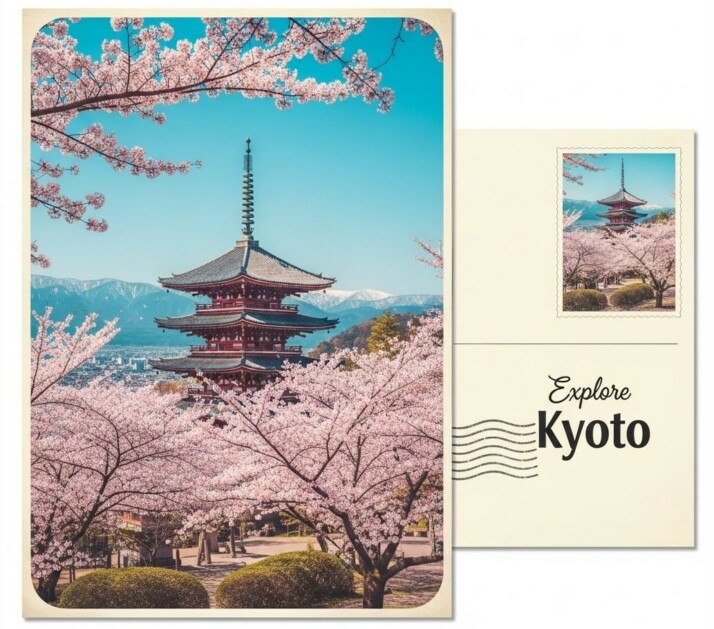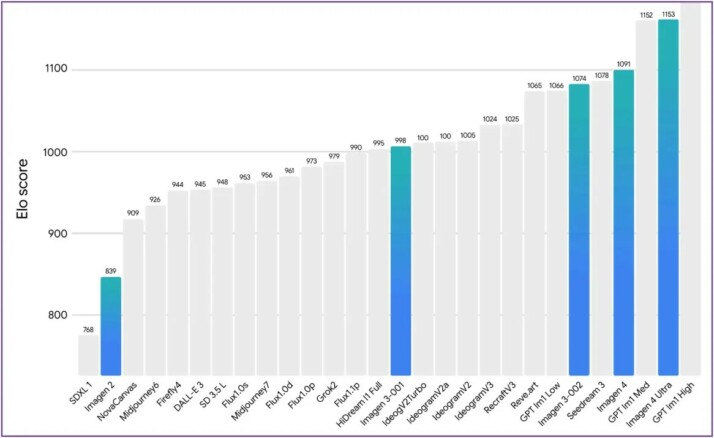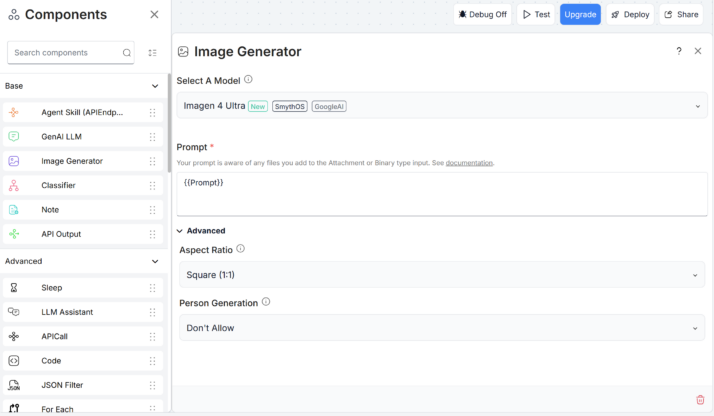Google released Imagen 4 on May 20, 2025. Is imagen 4 worth your time and budget?
It depends.
It’s undoubtedly DeepMind’s newest and most precise text‑to‑image model. Google touts “up to 2K” resolution, although the live presets are lower, and a fast tier that’s up to 10× quicker for rough drafts.
In this Imagen 4 review, we’ll show you what differentiates this model, what to expect, and how seamless it runs on SmythOS.
What is Imagen 4?
Imagen 4 is DeepMind’s updated text‑to‑image model, focused on cleaner text and stricter prompt following. Same latent diffusion lineage as Imagen 3, but the outputs are cleaner.
The model now obeys camera and style directions more accurately than before. Google markets “up to 2K” resolution. There’s also a fast tier that’s roughly 10× quicker than the standard/ultra modes. It’s meant for ideation.
Unfortunately, every image carries a SynthID watermark. You don’t get to turn that off.
Imagen 4 Benchmarks, Speed, and Key Features
Here’s what ships with the model, how it looks, and how fast it moves:
Image Fidelity & Photorealism
Imagen 4 renders materials, edges, and lighting more convincingly than Imagen 3. What this means is: Glass looks like glass, skin tones don’t smear as quickly, and depth‑of‑field effects hold together without melting detail.
Want to see how that works in real time?

Take a look at what Google developers created using this prompt: Photograph of an adventurous couple hiking on a mountain peak at sunrise, arms raised in triumph, epic panoramic view of valleys below, dramatic light.
It still slips on ultra-fine geometry, microtext on a circuit board, and filigree on jewelry, especially when the scene is crowded. But the baseline realism is higher.
Text Inside Images
Long labels, poster copy, and UI strings now land far more often. You can ask for a full sentence on a bottle and usually get it.
The weak spots are tiny fonts, tight curves, or text that has to wrap around objects. Those can blur or drop characters.
In short: better, but don’t expect magic just yet.
Instruction Following & Composition
Imagen 4 listens more closely to camera language like”strict nadir,” or “35 mm close‑up. Also, lighting cues like”rim light,” or “bioluminescent glow, and simple counts like “three glass marbles”.
Here’s a proof based on Google’s test using this prompt: Front of a vintage travel postcard for Kyoto: iconic pagoda under cherry blossoms, snow-capped mountains in distance, clear blue sky, vibrant colors.

It may still wobble on exact numbers or perfectly symmetric layouts, so if precision matters, plan for retries or post‑editing.
Resolution & Aspect Ratios
Google markets outputs “up to 2K” on the long edge. The presets you get from today’s API are lower; the current defaults are below 2K.
If you need true print sizes, use Imagen’s built‑in upscaler endpoint or your own. Aspect ratios are preset; you pick from the few Google exposes.
Speed Tiers & Latency
There are three variants of the same model.
Fast, which Google claims is up to 10× faster than Imagen 3. Standard and finally, Ultra. Fast is for sketching ideas cheaply. The ultra is for the version your client signs off on. All three live behind the same endpoint, just swap model IDs.
Safety Prompts
Prompts that touch public figures, explicit violence or sex, self‑harm, and similar topics get blocked at the API level.
Post‑generation checks and red‑teaming add another safety layer. If your workflow demands “clean” assets, get policy sign‑off on any post‑processing.
Architecture & Training Pipeline
Imagen 4 is latent diffusion. It was trained on a very large image–text corpus that Google aggressively filtered for low quality, PII, AI‑generated, and duplicate content.
Gemini generated synthetic captions to make the model follow instructions more reliably. Training ran on TPU pods using JAX/Flax.
How it Stacks up to Other Models Based on Evaluations
Beyond mere words, Google out the Imagen 4 to test. It did perform well compared to others.
They handed the model to real people and scored it on GenAI‑Bench.Testers judged three things that matter. Does the picture match the prompt? Does it look good? And which one would you pick if you had to choose?
In those head‑to‑heads, Imagen 4 landed near the top.

Clearly, the Elo scores show the GPT’s image model sits above Imagen 4 for overall preference. Imagen 4 ultra is close behind, making it the second highest compared to other models like Dall-e 3 or seedream 3. By all standards, it’s Google’s best text-to-image model yet.
Downsides of Imagen 4: Is It Perfect?
Every model has quirks. Imagen 4 is clear about its own.
For a start, the watermark isn’t optional. SynthID is embedded in every output. If “clean” files are mandatory, you’ll need an approved post‑process or a different model. Check the policy before you strip anything.
Filters are strict and sometimes opaque. Public figures, graphic violence, self‑harm, and sexual content are blocked. Sometimes, innocuous prompts hit a banned phrase. Rephrase with the same intent; don’t burn time arguing with the filter.
Fast vs. Ultra is a process decision. Use Fast while you’re exploring. Pay for Ultra once the prompt is right. The Standard is the budget compromise.
Counting and spatial precision are fragile. “Seven screws in a perfect circle” or “text perfectly centered on a tiny label” can miss. Add a retry or fallback (e.g., SDXL + ControlNet) if exactness is critical.
Test the Imagen 4 Component on SmythOS

Wondering how you can tap into Imagen 4’s abilities while building an agent? Great news! Imagen 4 is now on SmythOS. Getting it running in SmythOS’s visual builder is about 3 clicks and 2 wires.
Here’s how it goes, start to finish.
- Select the Image Generator component and drag it onto the canvas.
- Click the gear icon on the component to select Imagen 4 (Any of the tiers: Fast, standard, or ultra)
- Click the prompt field to insert a detailed and precise prompt to ensure accuracy.
- Advanced settings: Select the aspect ratio (portrait, landscape, or square)
- When the component receives an input or prompt, it generates a reference to the new image for the next step in your workflow.
When to use this: non‑technical teammates need to tweak prompts, or you’re prototyping and value speed over knobs.
Wrapping Up
Imagen 4 is a high‑compliance image model with real speed tiers and real guardrails. Use Fast to explore, Ultra to ship, and budget an upscaler if you promise big canvases.
In SmythOS, the Image Generator component allows for speed. Run a small test suite on your own prompts, keep the winners, and revisit when pricing or caps shift. That’s the only way these benchmarks matter to you.
